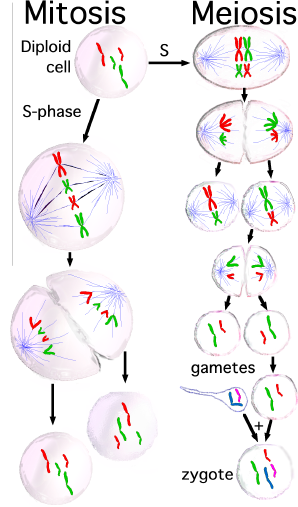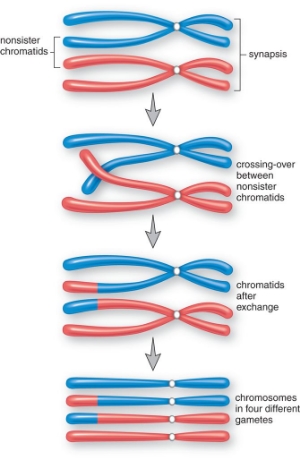Meiosis
Like mitosis, meiosis is a process of nuclear division. However, where mitosis leads to an exact copy of the chromosomes, meiosis results in producing new cells with exactly half the DNA as the parent cell. Meiosis is how gametes (sperm and eggs) of organisms are created. From a single cell, meiosis produces 4 daughter cells, each with half of the DNA of its parental cell. However, each has a different combination of chromosomes. Following meiosis, sex cells from different organisms merge creating recombined, genetically unique offspring every generation. This leads to an increase in diversity of the gene pool, which has evolved as an effective strategy to be adaptive in our ever-changing world.
Chromosomes role in sexual reproduction
Humans have 46 chromosomes, 23 come from your mother and 23 come from your father. Of the 23 unique chromosomes you got from each parent, each one pairs up precisely with its partner from your other parent during fertilization. This pairing is called a homologous pair.
Whenever fertilization happens, meiosis cells become diploid. This means there are two sets of the same chromosomes. This is expressed by the term 2n. And since we get 23 sets of chromosome from each parent, humans have 46 total chromosomes. This is notated as 2n=46. Therefore most cells in your body have 46 chromosomes in 23 homologous pairs, one chromosome from your mother (maternal chromosome) and one from your father (paternal chromosome).
Interphase preceding Meiosis
During interphase before meiosis begins, chromosomes duplicate and produce sister chromatids of each chromosome. It is important to be able to understand chromosomal terminology to fully understand meiosis. Prior to the S phase, each homologous pair of chromosomes (one paternal and one maternal chromosome of the same type) are unreplicated. These are known as unreplicated chromosomes. During the S phase, the unreplicated chromosomes replicate. The replicated strands are called sister chromatids, which are identical copies of each other connected at the centromere. Each homologous pair of chromosomes has two pairs of sister chromatids. Each pair of connected sister chromatids are called chromosomes: one maternal chromosome (with two sister chromatids) and one paternal chromosome (also with two sister chromatids). In other words, unreplicated and replicated chromosomes are considered single chromosomes, even though replicated chromosomes have two copies of DNA strands attached. Furthermore, chromatids from a maternal chromosome are said to be non-sister chromatids to the homologous paternal chromosome.
Early Prophase I of Meiosis
Much like mitosis, Early Prophase I of meiosis begins with chromosomes condensing and the nuclear envelope beginning to disintegrate. Unlike prophase of mitosis, homologous chromosome pairs (i.e. maternal and paternal chromosome pairs) come together forming a tetrad, in which the four chromatids are connected along the length of each chromatid. Chromatids from different homologous pairs are referred to as non-sister chromatids.
Late Prophase I of Meiosis
Crossing over during Late Prophase I of Meiosis
In late prophase I, the nuclear envelope completely breaks down and the spindle fibers attach at the kinetochores of the tetrads. Non-sister chromatids begin separating along several points along their length. Places where they stay connected are known as chiasmata. Chiasmata are where DNA was broken and rejoined between adjacent non-sister chromatids of homologous pairs. These chromosome segment exchanges are known as crossing over.
Metaphase I of Meiosis
In Metaphase I, all of the tetrads align along the metaphase plate. At this point, crossing over has completed, and the chromosomes are referred to as recombinant chromosomes. In your example, we are are only working with a single tetrad, so you are not able to visualize several tetrads aligning.
Anaphase I of Meiosis
In Anaphase I, the tetrads are separated and pulled toward opposite poles. At this point the recombinant chromosomes are haploid.
Telophase I and Cytokinesis I of Meiosis
In Telophase I, the nuclear envelope reappears around each group of recombinant chromosomes, and during Cytokinesis I the cytoplasm divides.
Telophase I and Cytokinesis I of Meiosis
In Telophase I, the nuclear envelope reappears around each group of recombinant chromosomes, and during Cytokinesis I the cytoplasm divides.
Meiosis II
In Meiosis I, chromosomes recombine in Metaphase I and become haploid in Anaphase I. During Meiosis II, the main purpose is to split the recombinant chromosomes from each other. Prophase II through Cytokinesis II is very similar to mitosis with recombinant chromosomes in place of sister chromatids.
Return to The Cell Cycle










